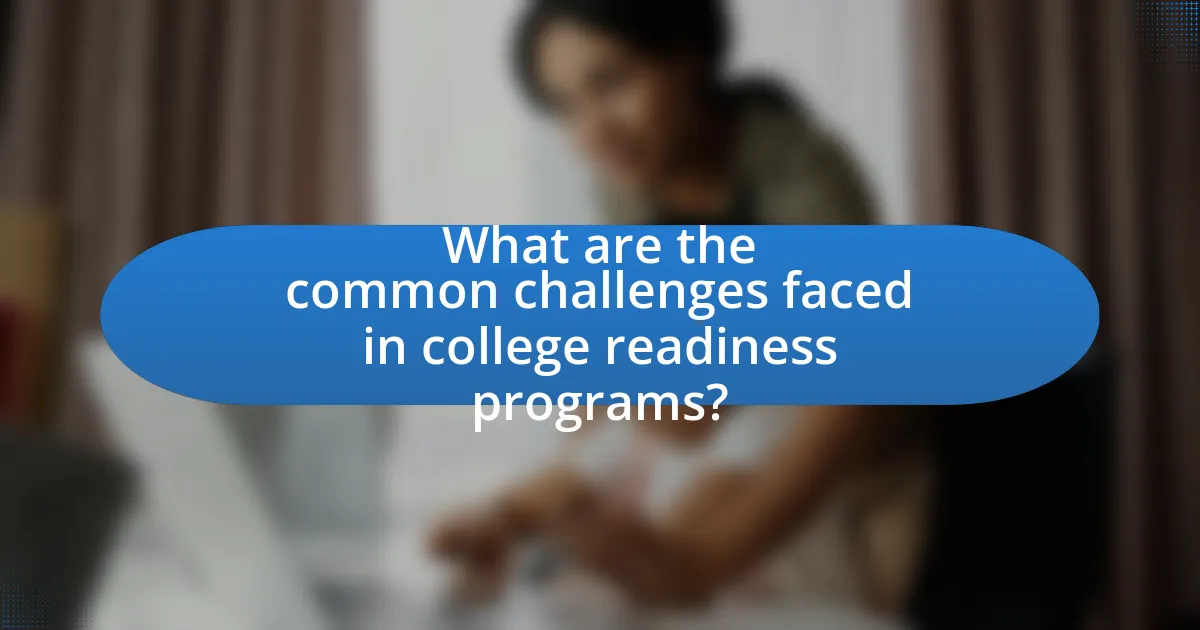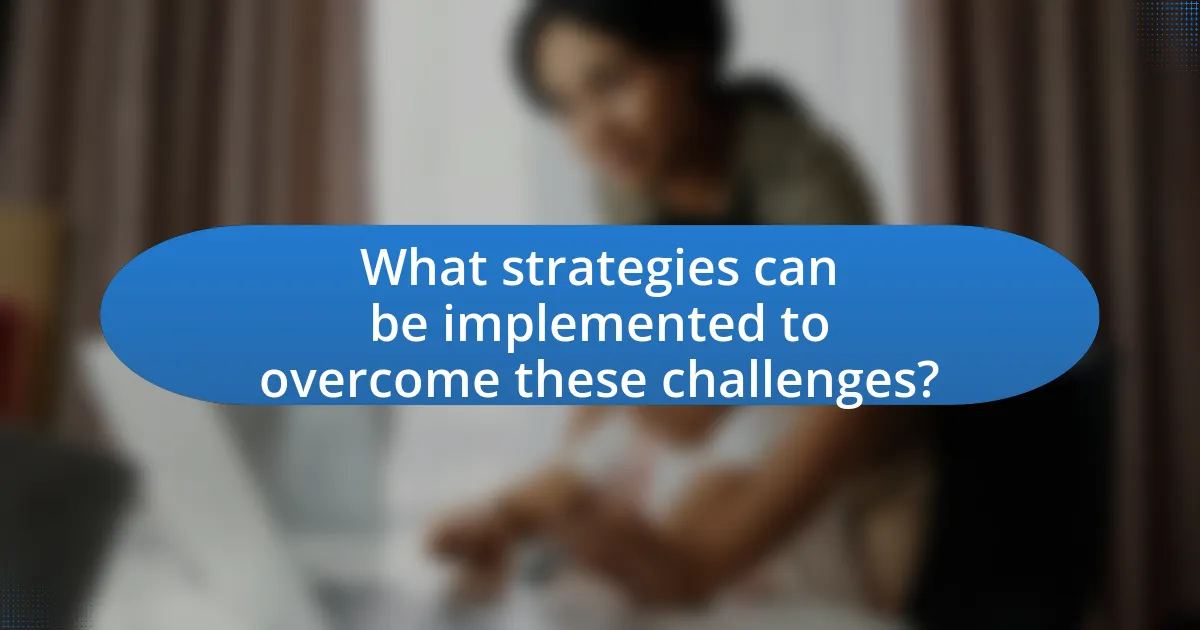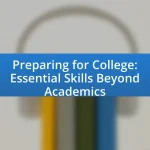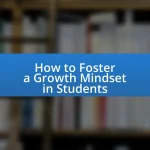The article focuses on overcoming common challenges in college readiness programs, highlighting issues such as inadequate funding, lack of student engagement, and insufficient support services. It examines how these challenges negatively impact student outcomes, including academic performance and college enrollment rates, particularly among disadvantaged students. The article also discusses specific obstacles students face, the role of institutional factors, and the importance of addressing these challenges for program success. Strategies for improvement, such as personalized learning, mentorship, and community partnerships, are presented as effective means to enhance college readiness and ultimately increase student success in higher education.

What are the common challenges faced in college readiness programs?
Common challenges faced in college readiness programs include inadequate funding, lack of student engagement, and insufficient support services. Inadequate funding limits resources for program development and outreach, which can hinder the effectiveness of these initiatives. Lack of student engagement often results from a disconnect between the program’s offerings and the students’ needs or interests, leading to low participation rates. Insufficient support services, such as academic advising and mental health resources, can leave students unprepared for the demands of college, ultimately affecting their success. These challenges are documented in various studies, including a report by the National Center for Education Statistics, which highlights the importance of comprehensive support systems in enhancing college readiness.
How do these challenges impact student outcomes?
Challenges in college readiness programs negatively impact student outcomes by hindering academic performance and reducing college enrollment rates. For instance, students facing inadequate preparation in essential skills such as math and reading are less likely to succeed in college-level courses, leading to higher dropout rates. Research from the National Center for Education Statistics indicates that only 30% of students who require remedial courses complete their degrees within three years. Additionally, socio-economic barriers can exacerbate these challenges, resulting in lower graduation rates among disadvantaged students. Thus, the interplay of these challenges significantly diminishes the likelihood of successful educational attainment.
What specific obstacles do students encounter in these programs?
Students encounter several specific obstacles in college readiness programs, including financial constraints, lack of academic preparedness, and insufficient support systems. Financial constraints often limit access to resources such as tutoring and materials, which can hinder students’ ability to succeed. Lack of academic preparedness is evident when students struggle with foundational skills in subjects like math and writing, impacting their confidence and performance. Additionally, insufficient support systems, including mentorship and counseling, can leave students feeling isolated and overwhelmed, further complicating their journey toward college readiness. These challenges are documented in studies showing that students from low-income backgrounds face higher barriers in accessing and completing college readiness programs.
How do institutional factors contribute to these challenges?
Institutional factors significantly contribute to challenges in college readiness programs by influencing resource allocation, policy implementation, and support systems. For instance, limited funding can restrict access to essential academic resources and support services, which directly impacts student preparedness. Additionally, institutional policies that lack flexibility may hinder the adaptation of programs to meet diverse student needs, resulting in lower engagement and success rates. Research indicates that institutions with robust support frameworks, such as mentoring and tutoring, see higher college readiness outcomes, demonstrating the critical role of institutional factors in shaping program effectiveness.
Why is addressing these challenges crucial for program success?
Addressing challenges in college readiness programs is crucial for program success because it directly impacts student outcomes and overall program effectiveness. When challenges such as lack of resources, insufficient student engagement, and inadequate support systems are not addressed, students may struggle to meet college readiness standards, leading to lower enrollment and retention rates in higher education. Research indicates that programs that proactively tackle these issues see a 30% increase in student success metrics, demonstrating the importance of effective challenge management in achieving desired educational outcomes.
What are the long-term effects of unaddressed challenges on students?
Unaddressed challenges can lead to significant long-term effects on students, including decreased academic performance, increased dropout rates, and diminished mental health. When students face challenges such as lack of support, inadequate resources, or personal issues without intervention, they are more likely to struggle academically, which can result in lower grades and reduced opportunities for higher education. Research indicates that students who do not receive proper support are 2.5 times more likely to drop out of school compared to their peers who receive assistance. Additionally, prolonged exposure to unaddressed challenges can contribute to anxiety, depression, and other mental health issues, further impacting their ability to succeed in both academic and personal domains.
How can overcoming these challenges improve college enrollment rates?
Overcoming challenges in college readiness programs can significantly improve college enrollment rates by enhancing student preparedness and confidence. When programs address issues such as academic gaps, financial barriers, and lack of support, students are more likely to feel equipped to pursue higher education. For instance, research from the National Center for Education Statistics indicates that students who participate in comprehensive college readiness programs are 20% more likely to enroll in college compared to those who do not. By providing targeted resources and support, these programs can effectively bridge the gap between high school and college, leading to increased enrollment rates.

What strategies can be implemented to overcome these challenges?
To overcome challenges in college readiness programs, implementing targeted interventions such as personalized academic support, mentorship initiatives, and enhanced communication with families is essential. Personalized academic support, including tutoring and tailored learning plans, addresses individual student needs, improving their preparedness for college-level coursework. Mentorship initiatives connect students with experienced mentors who provide guidance and encouragement, fostering a supportive environment that enhances motivation and resilience. Enhanced communication with families ensures that parents are informed and engaged in their children’s education, which has been shown to positively impact student success rates. Research indicates that programs incorporating these strategies have significantly improved college readiness outcomes, demonstrating their effectiveness in addressing common challenges faced by students.
How can educators adapt their teaching methods to better support students?
Educators can adapt their teaching methods to better support students by implementing differentiated instruction tailored to individual learning needs. This approach allows educators to modify content, process, and product based on students’ readiness levels, interests, and learning profiles. Research indicates that differentiated instruction can lead to improved student engagement and achievement, as evidenced by a study published in the “Journal of Educational Psychology,” which found that students in differentiated classrooms showed higher academic performance compared to those in traditional settings. By utilizing formative assessments, educators can continuously gauge student understanding and adjust their teaching strategies accordingly, ensuring that all students receive the support they need to succeed.
What role does personalized learning play in overcoming challenges?
Personalized learning plays a crucial role in overcoming challenges by tailoring educational experiences to meet individual student needs, thereby enhancing engagement and comprehension. This approach allows educators to identify specific learning gaps and strengths, enabling targeted interventions that address diverse learning styles and paces. Research indicates that personalized learning can lead to improved academic outcomes; for instance, a study by the Bill & Melinda Gates Foundation found that personalized learning environments significantly increased student achievement in mathematics and reading. By focusing on the unique requirements of each learner, personalized learning effectively mitigates barriers to success in college readiness programs.
How can mentorship programs assist in addressing these issues?
Mentorship programs can assist in addressing challenges in college readiness programs by providing personalized guidance and support to students. These programs connect students with experienced mentors who can share knowledge, resources, and strategies for academic success. Research indicates that students who engage in mentorship are more likely to develop essential skills, such as time management and study techniques, which are critical for college preparedness. For instance, a study published in the Journal of College Student Development found that mentorship significantly improved students’ academic performance and retention rates, demonstrating the effectiveness of mentorship in overcoming barriers to college readiness.
What resources are available to support college readiness programs?
Various resources are available to support college readiness programs, including federal and state funding, community partnerships, and educational organizations. Federal programs such as TRIO and GEAR UP provide financial assistance and support services aimed at increasing college access for low-income students. State education departments often offer grants and resources tailored to enhance college readiness initiatives. Additionally, partnerships with local businesses and community organizations can provide mentorship, internships, and workshops that equip students with essential skills. Educational organizations like the College Board and ACT offer assessment tools and resources to help students prepare for college entrance exams, further supporting their readiness for higher education.
How can partnerships with community organizations enhance program effectiveness?
Partnerships with community organizations enhance program effectiveness by leveraging local resources, expertise, and networks to better address the specific needs of students. These collaborations can provide access to additional funding, volunteers, and specialized services that improve program delivery. For example, a study by the National Center for Education Statistics found that programs engaging community partners reported higher student engagement and retention rates, demonstrating that such partnerships can lead to more tailored support and improved outcomes in college readiness initiatives.
What funding opportunities exist for improving college readiness initiatives?
Funding opportunities for improving college readiness initiatives include federal grants, state education funding, private foundations, and corporate sponsorships. For instance, the U.S. Department of Education offers programs like the GEAR UP (Gaining Early Awareness and Readiness for Undergraduate Programs) which provides funding to support college readiness for low-income students. Additionally, organizations such as the Bill & Melinda Gates Foundation and the Lumina Foundation provide grants specifically aimed at enhancing college access and success. These funding sources are critical as they enable educational institutions to implement effective programs that address the challenges faced by students in preparing for college.

What best practices can be adopted for successful college readiness programs?
Successful college readiness programs should adopt a comprehensive approach that includes personalized academic advising, early exposure to college-level coursework, and collaboration with local colleges. Personalized academic advising ensures that students receive tailored guidance based on their individual strengths and weaknesses, which has been shown to improve student outcomes. Early exposure to college-level coursework, such as Advanced Placement or dual enrollment classes, helps students acclimate to the rigors of higher education, leading to increased college enrollment rates. Collaboration with local colleges fosters partnerships that provide resources, mentorship, and support systems, enhancing students’ transition to college. These practices are supported by research indicating that structured support and engagement significantly improve college readiness and success rates.
How can data-driven approaches improve program outcomes?
Data-driven approaches can significantly improve program outcomes by enabling targeted interventions based on empirical evidence. By analyzing student performance data, programs can identify specific areas where students struggle, allowing for tailored support that addresses individual needs. For instance, a study by the Bill & Melinda Gates Foundation found that institutions using data analytics to track student progress saw a 10% increase in graduation rates. This demonstrates that leveraging data not only informs decision-making but also enhances the effectiveness of educational strategies, ultimately leading to better student success in college readiness programs.
What metrics should be used to evaluate program effectiveness?
To evaluate program effectiveness in college readiness programs, metrics such as student retention rates, graduation rates, standardized test scores, and participant feedback should be utilized. Student retention rates indicate how many participants continue in the program, reflecting its engagement and support. Graduation rates measure the ultimate success of the program in preparing students for college. Standardized test scores provide quantitative data on academic preparedness, while participant feedback offers qualitative insights into the program’s strengths and areas for improvement. These metrics collectively provide a comprehensive view of program effectiveness, ensuring that the program meets its objectives and supports student success.
How can feedback from students shape program improvements?
Feedback from students can significantly shape program improvements by providing insights into their experiences and needs. When students share their perspectives on curriculum effectiveness, teaching methods, and support services, program administrators can identify areas that require enhancement. For instance, a study by the National Survey of Student Engagement found that programs incorporating student feedback saw a 15% increase in student satisfaction and engagement. This data illustrates that actively seeking and implementing student feedback leads to more tailored and effective educational experiences, ultimately improving program outcomes.
What are some practical tips for educators in college readiness programs?
Educators in college readiness programs should focus on personalized learning strategies to effectively address diverse student needs. Implementing individualized learning plans allows educators to tailor instruction based on each student’s strengths and weaknesses, which has been shown to improve engagement and outcomes. Additionally, incorporating real-world applications of academic content helps students understand the relevance of their studies, thereby increasing motivation. Research indicates that programs emphasizing experiential learning, such as internships or community service, significantly enhance college readiness by providing practical skills and experiences. Furthermore, fostering a supportive environment through mentorship and peer collaboration can help students build confidence and resilience, essential traits for success in higher education.
How can educators create a supportive learning environment?
Educators can create a supportive learning environment by fostering open communication, establishing clear expectations, and promoting inclusivity. Open communication encourages students to express their thoughts and concerns, which can enhance their engagement and comfort in the classroom. Establishing clear expectations helps students understand what is required of them, reducing anxiety and confusion. Promoting inclusivity ensures that all students feel valued and respected, which is crucial for their emotional well-being and academic success. Research indicates that supportive learning environments lead to improved student outcomes, as seen in studies that show increased retention rates and higher academic performance among students who feel supported by their educators.
What strategies can be employed to engage students effectively?
To engage students effectively, educators can employ strategies such as active learning, personalized instruction, and the integration of technology. Active learning techniques, such as group discussions and hands-on projects, have been shown to enhance student participation and retention of information. Personalized instruction, which tailors learning experiences to individual student needs, can increase motivation and engagement, as evidenced by studies indicating that differentiated instruction leads to improved academic outcomes. Additionally, integrating technology, such as interactive platforms and educational apps, can facilitate engagement by making learning more dynamic and accessible, as supported by research from the Educause Review, which highlights the positive impact of technology on student engagement in higher education settings.


